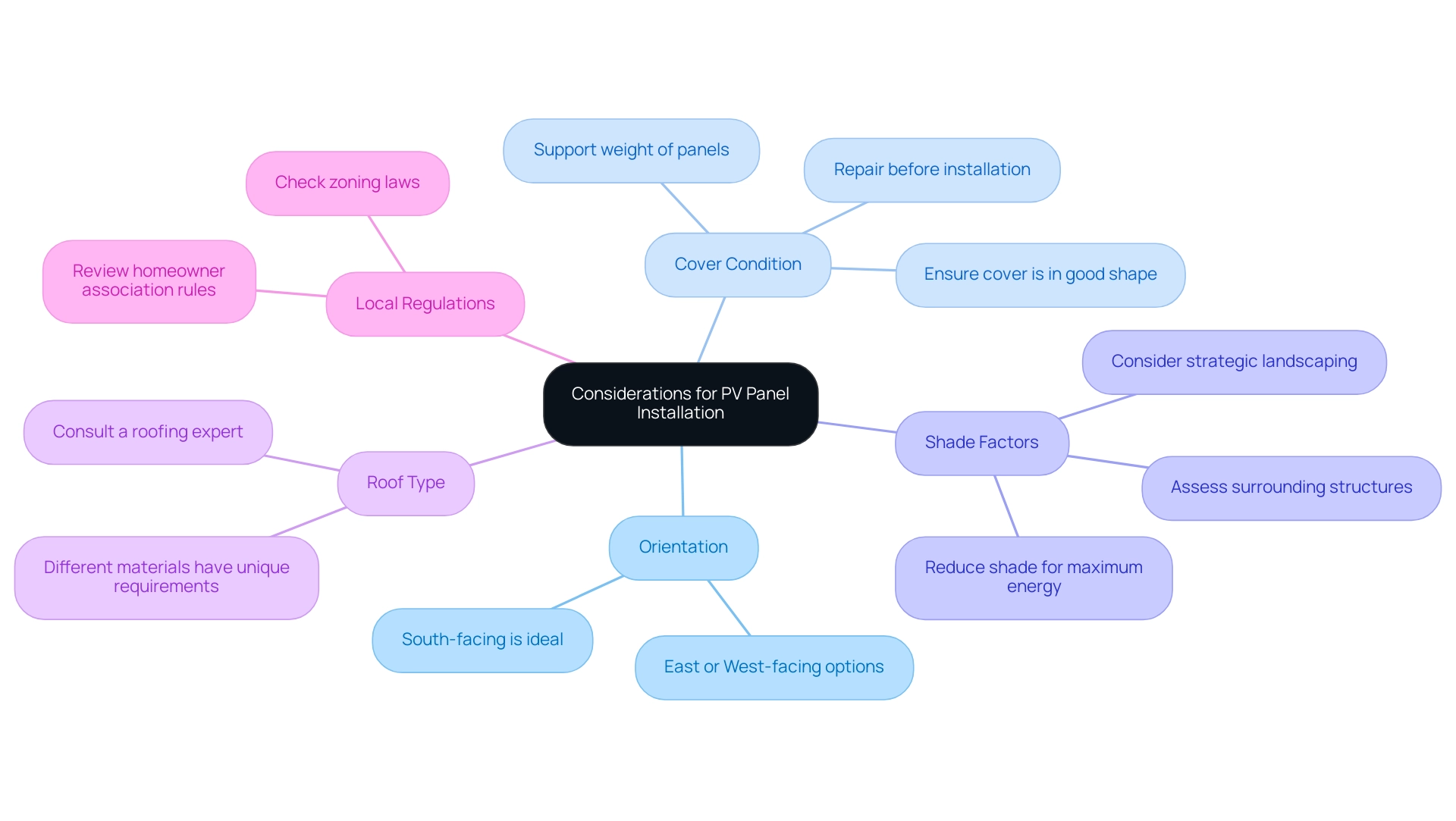Overview
PV roof panels, or photovoltaic panels, are essential for converting sunlight into electricity, offering homeowners significant energy savings and environmental benefits. The article outlines the installation process and advantages of these panels, emphasizing their ability to reduce reliance on fossil fuels, lower electricity costs, and contribute to job creation within the renewable energy sector, thereby promoting a more sustainable future.
Introduction
As homeowners increasingly seek sustainable energy solutions, photovoltaic roof panels have emerged as a top choice for harnessing the sun’s power. These innovative systems not only convert sunlight into electricity, significantly reducing reliance on traditional energy sources, but they also contribute to a greener planet.
With advancements in solar technology and supportive initiatives like the Solar for All program, the benefits of going solar are more accessible than ever. From understanding how these panels work to navigating the installation process and exploring financial incentives, this guide will provide homeowners with essential insights to make informed decisions about embracing solar energy.
Whether considering the environmental impact or the potential for cost savings, the journey to solar power is both rewarding and transformative.
Understanding Photovoltaic Roof Panels: Technology and Functionality
PV roof panels, often referred to as sunlight collectors, play an amazing role in harnessing the sun’s energy to generate electricity for your home. These components are crafted from semiconductor materials, typically silicon, which efficiently convert sunlight into usable power. When sunlight strikes the photovoltaic cells, it energizes electrons, creating an electric current that can be used immediately or stored in batteries for later use—how handy is that?
What’s more, these pv roof panels are designed to withstand various weather conditions, making them a reliable choice for homeowners. By harnessing sunlight, you can significantly lessen your dependence on conventional power sources, paving the way for a greener, more sustainable home. As we look towards 2024, ongoing advancements in renewable energy technology are expected to enhance both efficiency and effectiveness, empowering homeowners to embrace this eco-friendly option.
Significantly, 85% of installers utilizing NREL’s SolarAPP+ permitting software indicate that it simplifies the permitting process, encouraging more homeowners to adopt renewable energy solutions.
The advantages of transitioning to renewable energy extend beyond personal savings; they include substantial contributions to reducing greenhouse gas emissions and fostering job creation within the renewable energy sector. Initiatives like the Biden-Harris administration’s Solar for All program aim to enhance access to renewable power by providing financial incentives and resources to help homeowners adopt pv roof panels, ensuring that the benefits of such technology are equitably shared among various communities. With the global manufacturing capacity of photovoltaic systems projected to reach nearly 1,000 GW in 2024, the industry shows robust growth.
In fact, a recent case study titled ‘Optimism for 2024’ reveals that 34% of companies in the energy sector anticipate growth this year, showcasing the resilience and potential recovery of the market.
Step-by-Step Guide to Installing PV Roof Panels
- Assess Your Structure: Before diving into the solar installation process, take a moment to evaluate your structure. It should be structurally sound and free of any obstructions that may block sunlight. Ideally, a south-facing structure will capture the most sun, maximizing efficiency.
- Choose the Right Modules: With a variety of options available, research different types of PV roof panels. Look for those with high efficiency ratings and solid warranties to ensure a long-lasting investment. Consider the advantages of solar shingles, which can provide both visual attractiveness and utility, effortlessly blending into your structure while producing electricity.
- Obtain Permits: Don’t skip this step! Check your local regulations to find out what permits are necessary before installation. This can save you a lot of headaches down the road and ensure compliance.
- Install Mounting Hardware: Securely attaching mounting brackets to your roof is crucial. Ensure they are spaced appropriately for your sections to guarantee stability and safety.
- Connect the Modules: Now it’s time to carefully attach the PV roof panels to the mounting hardware. Follow the manufacturer’s guidelines closely for the best results.
- Electrical Connections: Connect the panels to an inverter, which is essential for converting the DC electricity they produce into AC electricity that your home can use. The inverter plays a crucial role in enhancing your power system, so choosing the appropriate one is essential for maximizing efficiency.
- Final Inspection: After everything is set up, it’s wise to have a professional take a look. This final inspection guarantees that your installation complies with all regulations and operates correctly, enabling you to enjoy the advantages of renewable power without concerns.
Financial Benefits: Keep in mind that the average 25-year savings from photovoltaic systems in Wyoming is approximately $5,916, making it a financially sound investment. Additionally, explore available incentives, such as state rebates and tax credits, that can significantly lower your costs.
Navigating the Process: It’s also essential to understand the interconnection process, which links renewable power systems to the grid. The Department of Energy’s SolarApp+ initiative aims to streamline this process, potentially lowering overall installation costs and reducing the time it takes to get your system operational. This initiative simplifies the permitting process, making it easier for homeowners to install energy systems efficiently.
For Long Beach tenants, there are environmentally friendly power solutions accessible that can make obtaining renewable sources simpler than ever. Consider engaging in local government programs aimed at assisting homeowners in their transition to renewable energy. These programs often provide financial incentives, such as rebates or grants, and may have eligibility criteria that can help make solar more accessible.
Environmental Benefits of PV Roof Panels: Reducing Carbon Footprint
Installing pv roof panels is one of the most effective ways homeowners can actively reduce their carbon footprint. Solar power stands out as a clean and renewable resource, generating power without emitting harmful pollutants. For every kilowatt-hour of sunlight energy produced, approximately 0.92 pounds of carbon dioxide emissions are prevented from entering the atmosphere.
This cumulative effect can lead to significant reductions in greenhouse gases over time. In fact, covering 80% of the roof area on commercial buildings in the U.S. with reflective material could offset 125 million tons of CO₂ over the structures’ lifetime. Moreover, adopting renewable energy reduces our dependence on fossil fuels, which contribute significantly to accelerating climate change.
Powercore Electric, a proud local specialist, is committed to assisting homeowners in navigating these advantages, ensuring they comprehend how to optimize their investments in renewable resources, particularly under the 200% Rule, which permits homeowners to install pv roof panels that can generate up to 200% of their power requirements. A significant illustration of the advantages of sunlight-related initiatives is observed in Nevada, where efforts in renewable resources workforce development are aiding in job creation and skills training, highlighting the state’s leadership in this field. By shifting to renewable power, we not only preserve essential natural resources but also aid in creating a cleaner, healthier environment for future generations.
Furthermore, substituting the roof and wall panels on the worldwide fleet of shipping containers with aluminum could save $28 billion in fuel, demonstrating the wider economic advantages linked to renewable power initiatives. At Powercore Electric, our team is constantly seeking methods to reduce your electric bill, and investing in renewable energy is a wise choice for both your finances and the environment. For instance, a recent case study highlighted a family in California who reduced their utility costs by 50% after installing pv roof panels tailored to their specific needs, demonstrating the tangible benefits of our customized approach.
Economic Advantages of PV Roof Panels: Cost Savings and ROI
Investing in pv roof panels can lead to remarkable reductions in your electricity bills—many homeowners report savings of 50% or more each month! For instance, Alabama residents enjoy estimated savings of about $125.06 monthly, while those in Wyoming can save around $96.82. It’s important to recognize that these savings vary significantly based on each state’s average price per kilowatt-hour and monthly power usage, as highlighted in various case studies.
Furthermore, numerous states provide attractive tax credits, rebates, and incentives that can greatly reduce your initial installation expenses, which generally vary from $15,000 to $30,000 based on the system size and local market factors, enhancing the appeal of renewable power. On average, you can anticipate a return on investment (ROI) for pv roof panels to range from 10% to 30%. With careful planning and consideration of your power requirements, homeowners can save tens of thousands of dollars over the lifespan of the pv roof panels, which often exceeds 25 years.
As Kerry Thoubboron aptly puts it, ‘Discover whole-home electrification.’ This statement not only highlights the financial benefits of renewable resources but also strengthens your dedication to an environmentally-friendly lifestyle. Furthermore, when assessing service providers, it’s essential to compare their offerings based on key criteria such as:
- Installation costs
- Warranty terms
- Customer reviews
- Service support
to find the best value, ensuring you make an informed decision that maximizes both savings and sustainability.
Is Your Roof Suitable for PV Panels? Key Considerations
When contemplating the installation of photovoltaic (PV) panels, there are several key factors to keep in mind to ensure you’re making a prudent investment in renewable resources:
- Orientation: Ideally, south-facing structures harness the maximum sunlight, but don’t overlook east or west-facing options—they can still generate significant energy. This is particularly crucial as the proper orientation can improve the efficiency of heating systems as well.
- Cover Condition: It’s essential to ensure your cover is not only in good shape but also capable of supporting the weight of the panels. If repairs are needed, it’s best to tackle those before installation to avoid complications down the line. A properly cared for covering can also help maximize the benefits of solar heating solutions.
- Shade Factors: Take a good look at your surroundings. Are there trees, buildings, or other structures that might cast shadows on your top during the day? Reducing shade is crucial to maximizing energy production and ensuring your system operates efficiently. Solar heating systems, whether active or passive, thrive in bright conditions, so strategic landscaping might also be worth considering.
- Roof Type: Different roofing materials—be it asphalt, metal, or tile—come with unique installation requirements. Consulting a roofing expert can assist you in navigating the best approach for your specific structure type, ensuring everything aligns perfectly. The appropriate covering can improve not only PV roof panels but also supplementary systems such as water heaters.
- Local Regulations: Lastly, don’t forget to check for any local zoning laws or homeowner association rules that might impact your energy installation. Keeping up to date with these regulations can prevent you from future troubles.
As the National Renewable Energy Laboratory (NREL) indicates, with around 3.3 million homes constructed or needing roof replacement each year, there’s a significant opportunity for photovoltaic capacity—about 30 gigawatts (GW) annually. Moreover, a structure measuring 2,000 square feet can generate roughly 52,000 kWh of power annually, emphasizing the considerable potential advantages of photovoltaic system installation. Insights from the case study titled ‘Future Directions in Rooftop PV Research’ indicate that advancements in photovoltaic technology will continue to enhance integration into building designs, further increasing efficiency and effectiveness.
This highlights the significance of comprehending your roof’s appropriateness for PV roof panels, which ensures you’re part of the growing movement towards sustainable living and energy efficiency. In addition to these considerations, it’s important to explore the different types of sunlight heating systems available. Active systems utilize advanced technology to provide consistent heating, while passive systems leverage natural design elements to capture and retain heat, offering a straightforward and cost-effective installation.
Solar water heaters, in particular, can lead to significant reductions in utility bills, making them a financially sound choice for many homeowners.
To learn more about how you can benefit from solar heating solutions, contact Powercore Electric Inc. today and start saving on your utility bills!
Conclusion
Embracing photovoltaic roof panels represents a significant step towards a more sustainable and economically savvy home. These innovative systems not only convert sunlight into electricity, but they also empower homeowners to reduce their reliance on traditional energy sources, leading to substantial savings on monthly bills. With financial incentives and supportive programs like Solar for All, transitioning to solar energy has never been more attainable.
The installation process may seem daunting at first, but breaking it down into manageable steps—from assessing roof suitability to securing necessary permits—can simplify the journey. Understanding the environmental benefits of solar energy further highlights its importance, as it plays a crucial role in reducing carbon footprints and combating climate change. By choosing to go solar, homeowners are not only investing in their financial future but also contributing to a healthier planet for generations to come.
Ultimately, the decision to install photovoltaic roof panels is a transformative one, blending economic advantages with a commitment to sustainability. As technology continues to advance and the solar industry grows, the opportunity to harness the sun’s power becomes more accessible. Joining the solar movement is not just about saving money; it’s about being part of a larger community dedicated to creating a cleaner, greener world.





